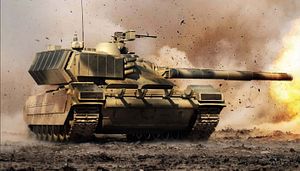Russia’s third-generation T-14 main battle tank (MBT), an armored vehicle based on the ‘Armata’ universal chassis system, is purportedly cheaper than European and U.S. third-generation models, the CEO of Uralvagonzavod—the largest tank maker in the world—claimed on June 16, according to TASS.
“Unfortunately, I can’t specify it [the price]. This is not my secret; this is the secret of the Defense Ministry. The only thing I can say is that this is today the cheapest armored vehicle, if we take our potential competitors in Europe and America,” Oleg Siyenko said.
The Armata universal chassis system—first revealed in 2015 during the May 9 Moscow Victory Day Parade on Red Square– is a platform for over a dozen different tracked vehicles, including a self-propelled artillery gun, an armored military engineering vehicle, and an armored personal carrier. Perhaps, the two most prominent Armata platforms are the T-14 MBT and T-15 new heavy infantry fighting vehicle (IFV).
As I explained previously (See: “Putin’s New ‘Wunderwaffe:’ The World’s Deadliest Tank?”): “The Russian military wants to replace 70 percent of its armor with new tracked vehicles based on the Armata universal chassis system, mustering out older T-72 and T-90 MBT models.” By 2020, Uralvagonzavod plans to produce 2,300 T-14 Armata models.
Whether the T-14 or T-15 will be cheaper than Western counterparts is impossible to verify independently. However, Russian armor has generally been cheaper in comparison to European and U.S. models for a number of reasons including different manufacturing methods, the advantage of economies of scale, and cheaper materials and technologies used during the production process.
Perhaps, one reason for Siyenko’s remarks is to assuage Russian fears that the T-14 will drain the Russia’s defense budget. As I explained in early 2016 (See: “Will 3D Printing Speedup Production of Russia’s ‘Deadliest Tank’?”):
[T]he steep price of the Armata–each tank purportedly costs about $8 million—has led the Russian military and the Russian public question the rationale behind mass producing such an overpriced vehicle. During the rehearsal for the 2015 Victory Day parade on Red Square in Moscow, bystanders supposedly made the joke: “The Armata truly has unprecedented destructive power; a battalion can destroy the entire Russian budget!”
According to some uncorroborated media reports, however, the price tag for the T-14 MBT could eventually fall to around 250 million rubles ($3.1 million) per unit or below once serial production begins. Indeed in March 2016, the CEO of Russian Technologies State Corporation (Rostec), Russia’s largest defense industrial conglomerate, claimed that T-14 is already in serial production. The head of Rostec, however, did not reveal the per-unit price of the MBT.
Nevertheless, a $3.1 million price tag for Russia’s first post-Soviet MBT, would indeed be substantially cheaper than European models with Germany’s Leopard 2a6 MBT costing around $6.7 million, and the U.S.-made Abrams M1 MBT about $6 million.

































